Method 1:
Get-SPDatabase | Sort-Object disksizerequired
-desc | Format-Table Name, @{Label ="Size in MB"; Expression =
{$_.disksizerequired/1024/1024}}
This lists all of your databases, from largest to smallest and their size in
MBs. Its output looks like this:
Name Size in MB
---- ----------
WSS_Logging 1657
SharePoint_Config 505
Search_Service_Application_PropertyS...
158
SharePoint_AdminContent_9cdc3220-ff2...
99
Search_Service_Application_DB_79408a...
99
WSS_Content 74
WSS_Content_OOTB_upgrade 46
WSS_Content_ac5e33ae4e354dd493b6da17...
26
wss_content_upgrade 26
WSS_Content_portal 24
Search_Service_Application_CrawlStor...
17
User Profile Service
Application_Pro... 7
Bdc_Service_DB_a95c44b879ef48f8a5307...
6
WebAnalyticsServiceApplication_Repor...
6
WebAnalyticsServiceApplication_Stagi...
5
Application_Registry_Service_DB_2f70...
4
Managed Metadata
Service_c23b61fed61... 3
managed_metadata_the_truth 3
User Profile Service
Application_Soc... 3
User Profile Service
Application_Syn... 2
StateService_783e168d26fd498b9be3061...
2
Secure_Store_Service_DB_89dc97ed2262...
2
PerformancePoint Service
Application... 2
WordAutomationServices_00a4e73d0d734...
2
That's pretty helpful, but it doesn't answer that burning question, how much
space is needed. I came up with this to answer that question:
Get-SPDatabase | ForEach-Object {$db=0} {$db
+=$_.disksizerequired; $_.name + " - " + $_.disksizerequired/1024/1024}
{Write-Host "`nTotal Storage (in MB) =" ("{0:n0}" -f ($db/1024/1024))}
Its output looked this this:
StateService_783e168d26fd498b9be3061299862269
- 2
Secure_Store_Service_DB_89dc97ed22624025ae6e9a69f2684978
- 2
WordAutomationServices_00a4e73d0d7341cdac915e8247da5211
- 2
User Profile Service
Application_SocialDB_f2c646049bfd4456b612e454ac1a73fd - 3
Bdc_Service_DB_a95c44b879ef48f8a53070abd98a9d03
- 6
WebAnalyticsServiceApplication_StagingDB_51bf4216-80fa-45d5-b580-b5d419c8e269
- 5
SharePoint_Config - 505
PerformancePoint Service
Application_c575f52198844d46a6c2d29c69a6594a - 2
Search_Service_Application_CrawlStoreDB_6c608154693c412bb9fc1e35235e502f
- 17
Search_Service_Application_PropertyStoreDB_d7726abcc15f425eb39428f3d6d983d4
- 158
Application_Registry_Service_DB_2f70cb1bdc274522ac5ca345df9de86e
- 4
SharePoint_AdminContent_9cdc3220-ff2c-4b52-abcf-ad9ce1ba463d
- 99
WSS_Content - 74
WSS_Content_ac5e33ae4e354dd493b6da176e9e6c84
- 26
WSS_Content_OOTB_upgrade - 46
WSS_Content_portal - 24
wss_content_upgrade - 26
Search_Service_Application_DB_79408a739be74c18ac0b44630382b13c
- 99
Managed Metadata
Service_c23b61fed6114e88af70931a2add3c36 - 3
managed_metadata_the_truth - 3
User Profile Service
Application_ProfileDB_15a709d2085741fb9ed182d6e77e2a4f - 7
WSS_Logging - 1654
User Profile Service
Application_SyncDB_9ff01258380945d99a5c9e8e110b6835 - 2
WebAnalyticsServiceApplication_ReportingDB_c7b9b6b2-f3d7-40c4-b72f-70a47e78deec
– 6
Total Storage (in MB) = 2,775
Method 2:
#Get SharePoint Content database sizes Add-PSSnapin Microsoft.SharePoint.PowerShell -ErrorAction SilentlyContinue
$date = Get-Date -Format "dd-MM-yyyy"
#Variables that you can change to fit your environment
$TXTFile = "D:\Reports\SPContentDatabase_$date.txt"
$SMTPServer = "yourmailserver"
$emailFrom = "SharePointReports@company.com"
$emailTo = "youradmin@company.com"
$subject = "Content Database size reports"
$emailBody = "Daily/Weekly/Monthly report on Content databases"
$webapps = Get-SPWebApplication
foreach($webapp in $webapps)
{
$ContentDatabases = $webapp.ContentDatabases
Add-Content -Path $TXTFile -Value "Content databases for $($webapp.url)"
foreach($ContentDatabase in $ContentDatabases)
{
$ContentDatabaseSize = [Math]::Round(($ContentDatabase.disksizerequired/1GB),2)
Add-Content -Path $TXTFile -Value "- $($ContentDatabase.Name): $($ContentDatabaseSize)GB"
}
}
if(!($SMTPServer) -OR !($emailFrom) -OR !($emailTo))
{
Write-Host "No e-mail being sent, if you do want to send an e-mail, please enter the values for the following variables: $SMTPServer, $emailFrom and $emailTo."
}
else
{
Send-MailMessage -SmtpServer $SMTPServer -From $emailFrom -To $emailTo -Subject $subject -Body $emailBody -Attachment $TXTFile
} |
The result
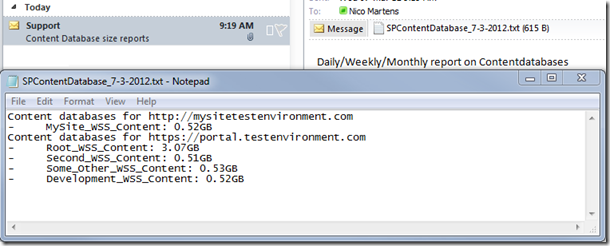 Scheduling the script
Scheduling the script Save the script (In my example: C:\Install\Get-SPContentDatabaseSize.ps1)
Start the Task scheduler:
Start –> Run: taskschd.msc Create a new task:
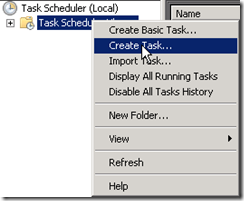 General
General 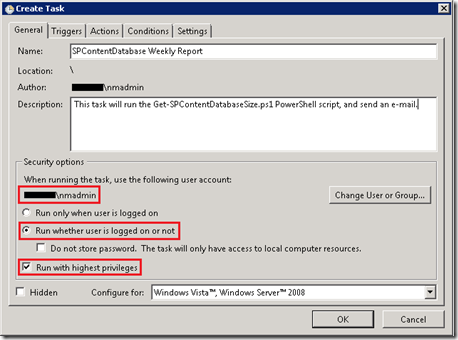
- Make sure the account running the task has sufficient permissions to access the databases
- “Run whether user is logged on or not” should be checked.
- Run with highest privileges has to be checked.
Triggers
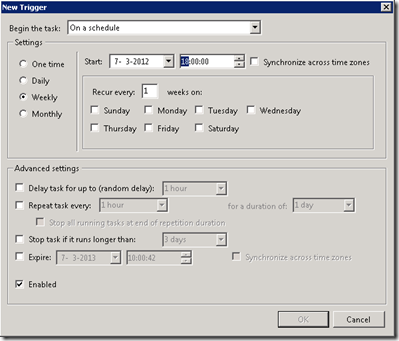
The triggers can be set to your requirements, in this example I scheduled the task weekly at 6PM.
Actions To run a PowerShell script as a scheduled task, you cannot simply add the C:\Install\Get-SPContentDatabaseSize.ps1 in the “Program/script” field.
You should do the following:
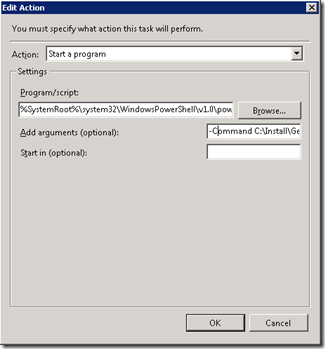
Program/script: %SystemRoot%\system32\WindowsPowerShell\v1.0\powershell.exe
Add arguments (optional): -Command C:\Install\Get-SPContentDatabaseSize.ps1





